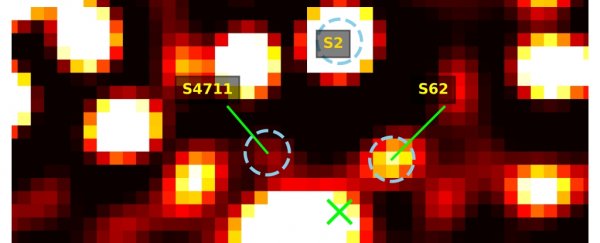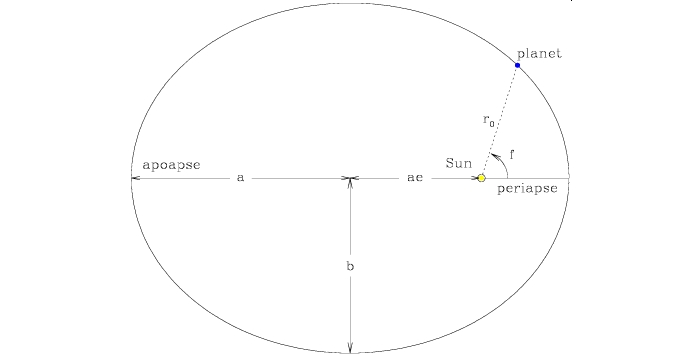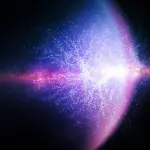Key Takeaways:
- S4714 zips around our galaxy’s supermassive black hole at 8% the speed of light.
- This discovery suggests stars like S4714 might be the first confirmed “squeezars,” tidally heated by black holes.
- Astronomers use stars like S2, S62, and the new group including S4711 and S4714 to study the black hole.
- Studying these stars helps test theories like Einstein’s General Relativity.
- Telescopes like the Extremely Large Telescope may reveal even more extreme stars near the black hole.

We have discovered the Milky Way’s fastest known star. A recently discovered star named S4714 orbits the supermassive black hole Sagittarius A* in the harsh environment at the center of our galaxy.
During its orbital journey, S4714 achieves an amazing velocity of 24,000 kilometers per second (15,000 miles per second), or about 8% of the speed of light. However, that isn’t even the most incredible thing.
A group of stars, including S4714, have been found to be skimming Sgr A* on closer orbits than any other stars found to date.
This discovery not only raises the possibility that there are even more stars circling the supermassive black hole in our galaxy on risky orbits, but it also provides the first candidates for a kind of star that was first proposed almost 20 years ago: stars that approach a black hole so closely that they are “squeezed” by the tidal forces of the hole. Another name for them is ‘squeezars’.
Although the Milky Way’s center is quieter than other, more active galactic centers, things can still get very crazy around a supermassive black hole that is in an inactive state.
Numerous stars in the area have been found to be on long, looping, sharply elliptical orbits around Sgr A*; think about an oval with the black hole at one end. This is how astronomers have come to identify these stars. We can use these stars, which go by the name S stars, to investigate the characteristics of the enormous invisible object they orbit.

S2 was thought to be the star closest to the black hole for many years. Its 16-year orbit brought it within about 18 billion kilometers of Sgr A* at its closest approach, or periapse. The star’s acceleration to 3 percent the speed of light was caused by the gravitational kick from this close approach. It’s taken painstaking work to observe and characterise this orbit.
However, a group led by German astrophysicist Florian Peissker of the University of Cologne discovered S62, a much fainter but closer star, last year.
On a 9.9-year orbit, it practically grazes Sgr A* at a periapse distance of 2.4 billion kilometres. That is closer than Uranus’s mean separation from the Sun. It reaches speeds of 20,000 km/s (12,400 mps) or 6.7% of the speed of light as it makes its way around.
Peissker and his group weren’t done, though. After years of research, five additional S stars—S4711, S4712, S4713, S4714, and S4715—that are even closer than S2 have been found.
“I am happy that I had the opportunity to work with and observe (with the Very Large Telescope) the Galactic center for the last 7 years,” Peissker stated to ScienceAlert.
“Since then, I have been working on the SINFONI (near-infrared) data. Data-reduction skills, excellent vision, patience, and luck are all necessary. And naturally, a solid understanding of low- and high-pass filters.”
S4711 and S4714 are the two new stars that stand out the most.
With a periapse distance of 21.5 billion kilometers, blue B-type star S4711, which is estimated to be 150 million years old, orbits Sgr A* once every 7.6 years, having an even shorter orbital period than S62.
It doesn’t skim as close, but because of its shorter orbital period, it has the shortest mean distance to the black hole that we currently know of over the course of its orbit.
S4714, on the other hand, has an orbit that is considerably more eccentric than S4711’s, lasting 12 years, meaning that its ellipse shape is elongated—about as elongated as a stable orbit can get, in fact. The values of orbital eccentricity range from 0 to 1, where 0 represents a perfect circle and 1 represents an escape orbit. The orbital eccentricity of S4714 is 0.985.
It skims closer than S62 at periapse, approaching Sgr A* by roughly 1.9 billion kilometers (1.2 billion miles). The star accelerates to 24,000 km/s during this close approach, then slows as it swings back out up to 250 billion km away from the black hole.
These extreme stars, Peissker said, are the first real candidates for squeezars, first theorised back in 2003.
A class of stars with extremely eccentric orbits around massive black holes was proposed by astronomers Tal Alexander and Mark Morris. A portion of the star’s close orbital energy is converted into heat by the tidal forces at each pass. This causes the star to shine brighter than it would normally and also accelerates the star’s orbital decay. Squeezars are, to put it another way, dead stars in orbit.
“At least S4711 and S4714 are squeezar candidates,” Peissker said. “I would say, I am sure about S4711 since the orbital elements are consistent with the predictions of Tal Alexander in 2003. In this sense, S4711 is the very first squeezar ever detected.”
If verified, these stars may provide light on how black holes interact with the stars they (finally) eat. However, they also present additional opportunities.
General relativity has recently been examined with S2, for instance. In some of the toughest tests to date, Einstein’s theory has been verified by the way the star’s light stretches as it gets closer to the black hole and by the way its orbit changes like a spirograph.
“We are actually one magnitude closer to Sgr A* and almost four times faster than S2 during its pericentre passage,” Peissker stated. “With that, we find actually stronger relativistic interactions with the stars S62, S4711, and S4714 as with S2.”
Since SINFONI was decommissioned, these tests have not yet been completed, so it might take some time to get observations. Still, it’s undoubtedly being monitored by astronomers.
The hunt for more of these nearby stars is ongoing as well. Even more extreme orbits and velocities might be hiding in the area surrounding Sgr A*; fortunately, we should be able to find them thanks to the launch of more potent telescopes in the upcoming years, such as the Extremely Large Telescope.
It’s all just a matter of time.
With a winky face emoji, Peissker stated, “I am pretty sure that this was not our last publication and I am constantly working on the galactic center.” “The high dynamical environment is for scientists like a candy-shop for children.”
The Astrophysical Journal has published the research.


